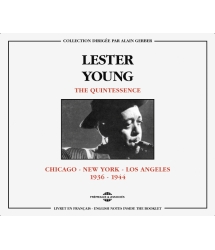Dispensing first with the negative : only one track with Billie Holliday, excused because of two other albumes available on the same label – wich sounds to me like a marketing ploy. Slightly off speed on Lester Leaps Again ; and Glenn Hardman’s organ playing. Pretty nearly everything else that can be said has to be positive, but only because I think there might be some strange Gallic logic in arranging the tracks in random order – unless the object was to give me a headache rearranging the personnel details. Musically, every track has merit, much excellent playing from the stars of the proceedings, fine support from the other great names on hand. The period covered, 1936 to 1944, was Young’s early peak (later he was different, better or worse being an idiosyncratic decision). Listening again to the poised elegance of his solos during this period it is striking how far he had turned away from the accepted sound and style of the saxophone tenor in jazz. The melancholy quality that marked much of Young’s playing, especially in his later years, is pre echoed here by his clarinet playing on the first version of Pagin’ The Devil. But mostly, there is joy and exuberance from his as, buoyed by some exceptionnal rhythm sections, he dances through famous and forgotten sessions. Amongst the other front line soloistsClayton, Coleman and Butterfield excel, as does Wells. Because of the settings (Basie grouos, classic sessions, etcetera) many redaers will already have much of this material in other forms. For a new comer it might well be attractive although the absence of the Holiday sides makes it less than irresisitable which brings me back to my comment about marketing strategy. It is, however, unfair to end on a negative note because Young’s playing here is amongst the lasting monuments to this true giant of jazz. Sound quality is generally good, Taxi War Dance being an exception, coming as it does from a somewhat fuzzily recorded live session. The lenghtly sleeve note is in French with a shorter adaptation into English by Don Waterhouse.
Bruce CROWTHER – JAZZ JOURNAL INTERNATIONAL
Bruce CROWTHER – JAZZ JOURNAL INTERNATIONAL











